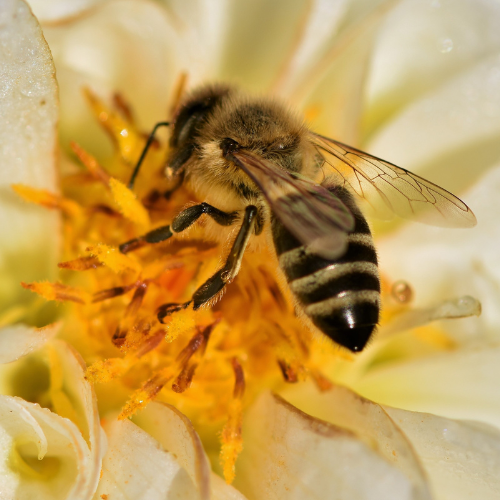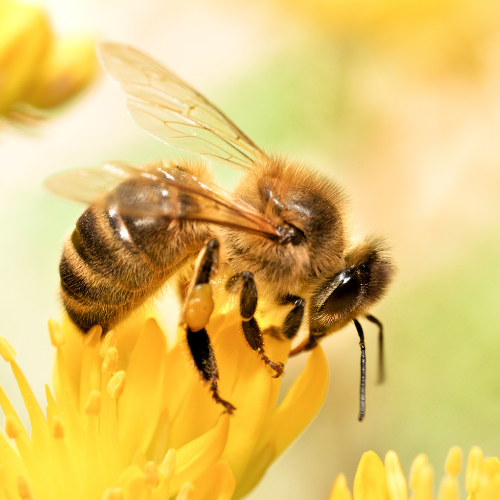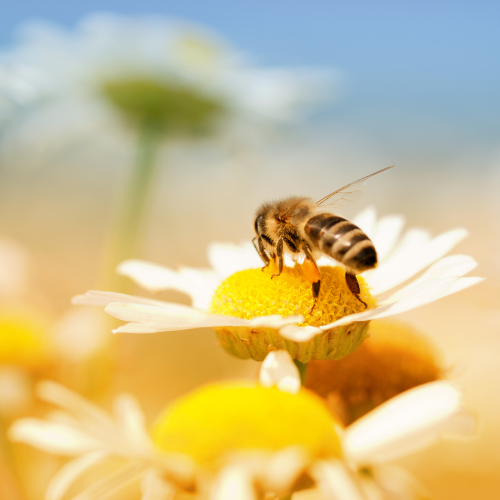Honey Bees
Introduction to
Honey bees are essential pollinators known for their ability to produce honey and their crucial role in agriculture and ecosystems. While they are generally beneficial, their nests near human habitation can sometimes pose problems. This guide provides detailed information on how to recognize, understand, and manage honey bees, including preventive measures and professional pest control solutions.
Recognition
Honey bees (Apis mellifera) are small to medium-sized insects, typically measuring about 1/2 inch in length. They have a distinctive golden-brown color with dark bands across their abdomen and a slightly fuzzy appearance due to fine hairs on their bodies. Honey bees have two pairs of wings, six legs, and large, compound eyes. Unlike some other bee species, honey bees have a more slender body shape. They are often seen foraging on flowers, where they collect nectar and pollen.
Biology
Honey bees belong to the family Apidae and are highly social insects that live in large colonies. A typical colony consists of one queen, thousands of worker bees, and several hundred drones. The queen is the sole reproductive female, laying thousands of eggs. Worker bees, which are sterile females, perform all other colony tasks, including foraging, nursing the young, and maintaining the hive. Drones are male bees whose primary role is to mate with virgin queens. Honey bees undergo complete metamorphosis, developing from eggs to larvae to pupae to adults. They are well known for their ability to produce honey, which they store in hexagonal wax cells within the hive.
Habits
Honey bees are active during the warmer months and are primarily focused on foraging for nectar and pollen to feed the colony. They are excellent pollinators and play a critical role in the pollination of many plants and crops. Honey bees communicate through a complex system of pheromones and the famous “waggle dance,” which helps them convey information about food sources to other members of the colony. While honey bees are generally non-aggressive, they will defend their hive vigorously if threatened. They can sting only once, as their barbed stinger becomes lodged in the skin, leading to the bee’s death.
Prevention
Preventing honey bee nests near your home involves regular inspection and maintenance. Check for potential nesting sites, such as hollow trees, wall cavities, or eaves, and seal any openings to prevent bees from establishing a colony. Ensure that outdoor trash bins are tightly sealed to avoid attracting bees. If you have a garden, consider planting bee-friendly flowers away from high-traffic areas to encourage bees to forage without posing a risk to human activity. Avoid using strong-smelling chemicals or perfumes outdoors, as these can attract bees. If you discover a hive or swarm on your property, do not attempt to remove it yourself; instead, contact a professional beekeeper or pest control service.
Professional
When honey bee nests become a concern, professional pest control services can offer effective and humane solutions. STL Pest Control provides comprehensive inspections and tailored treatment plans to address honey bee infestations. Their methods include safely relocating honey bee hives to appropriate locations, ensuring that the bees are preserved and their pollination benefits maintained. Professional services ensure that the infestation is managed efficiently and safely, minimizing the risk to humans and pets while respecting the ecological importance of honey bees.



Our Office









